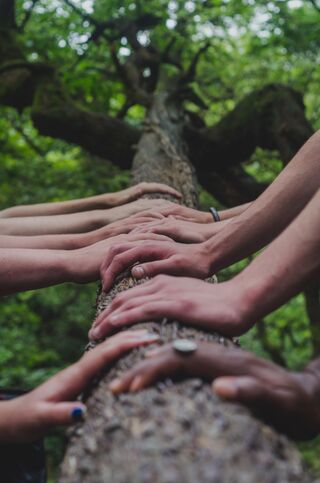Personality
The Persona, and Where to Get to Know Your Naked Personality
What type of person are you underneath the archetypal faces you put on?
Posted December 8, 2022 Reviewed by Michelle Quirk
Key points
- Our personas are made of the ways we mediate between ourselves and our roles in relationships, communities, and society.
- We must be aware of our own personas, especially those we most closely identify with an idealized sense of self we wish to project.
- Friendship demands we take off the social masks that aid in our societal living and protect us from potential hurt.

Consider the symbolic clues guiding others toward an image of you that you wish them to perceive. Perhaps certain books conspicuously placed. Hints of status adorning social media profiles and of special knowledge and understanding lacing professional banter and tweets. The style of vehicle, clothing, art, and other external trappings of lifestyle. Even the manner of voice, choice of hobbies, and the company you keep.
Who is it that you wish to convince the world you are? What nearly veiled lengths do you go to on a routine basis to keep up the convincing?
Perhaps none of this, for you, is about convincing, about perception, about image. Perhaps you are the authentic, whole, unvarnished individual, immune from the draws of collective unconscious and archetypal embodiments through which the rest of us morph and cope, as needed. And perhaps, for you, no shadow bubbles up from the anima that misaligns with a persona that does not exist because it is not needed, because you are at your very core the version of you that you wish the world to perceive—nay, you wish for nothing, but merely experience life in mindful ease.
Or perhaps, on occasion, your Dr. Jekyll turns into Mr. Hyde who behaves in ways that are not acceptable in Dr. Jekyll's life. Perhaps you experience yourself behaving in one setting, in one moment, with one person, in ways you had not intended to reveal that you are elsewhere. Perhaps you recognize on the other side of a life-changing event that a collection of accessories and behaviors is no longer meaningful, or needed, or wanted, and can be discarded, along with the image they project.
Our Roles
Our personas are made up of the ways that we mediate between ourselves as we are underneath and our roles in relationships, communities, and society. They are the faces we put on. What type of person are you besides those trappings and underneath the archetypal masking?

What irritates or infuriates you so that you react beyond proportion to whatever triggered you? Perhaps you feel yourself overreacting; you recognize the experience of it, and, yet, in those moments, self-regulation is fleeting. Look into those moments for clues to the submerged ego and shadow beneath the cooler surface of your personas.
As our ego is faced with the demands of reality and must continually make decisions about how to adapt to these demands, we make choices, consciously or unconsciously, as to what attitude we will present and bring into the relational spheres of our lives. Our underlying predispositions, including the type of temperament and personality we embody, heavily influence our manner of instinctual adapting—how we show up and feel underneath and drive toward in the interpersonal give and take—but the image of the person we present doing so is persona situating us within a collective identification and experience. While underlying typological features of personality are more or less immutable, archetypical persona is a thin veneer representing compromises between self and society.

Persona certainly is functional, yet it can be stifling. For example, persona acts as buffer for self-regulatory processes sometimes necessary for presenting oneself in a particular role and setting with a particular set of people and, in some aspects, can even serve as a defense against potential threats in the social environment. Yet friendship is a social territory in which its devices can become problematic to the extent, over the course of friendship, that it works against vulnerability. For we are not merely selves but are each a multiplicity of selves, in a manner of speaking.
Friendship
C.S. Lewis alluded to the intra-active and healthful multiplicity of self called upon in friendship when he wrote, "In each of my friends there is something that only some other friend can fully bring out" (p. 61, 1960). That is no reference to persona, a functional veneer, but to the depths and diversity within called upon and activated by friendship, from which persona, then, may protect against. The lesson here is that we must be careful to be aware of our own personas and especially those we most closely identify with an idealized sense of self we wish to project. To the extent we conflate persona with self, we may lose capacity and flexibility to draw from our own depths.

This, again, is where friendship is life-giving. It demands we take off the social masks that aid in our societal living and protect us from potential hurt. "This," said Lewis (1960), "is the kingliness of Friendship. We meet like sovereign princes of independent states, abroad, on neutral ground, freed from our contexts" (p. 70). And so the presence of persona is nearly ubiquitous, but only nearly, and for each of us, hopefully only nearly, as it is when we shed our societal costumes that we have the opportunity to be in the most relaxed and generative state of psychological and spiritual growth as a person, to tap into latent potentialities of our own veiled multiplicity.
Lewis noted that friend love ignores "that whole embodiment which consists of our family, job, past and connections" and distinguished this from the kind of "general character" we are able to strip down to even within family life at home, where responsibilities still maintain the need for not only the fulfillment of duty to those within family but also, frankly, the dances of role and ego boundary dispensed effortlessly in true, deep friendship. Again, Lewis: "Eros will have naked bodies; Friendship naked personalities" (1960, p. 71).
References
Lewis, C. S. (1960). The Four Loves. New York: Harcourt, Brace.


